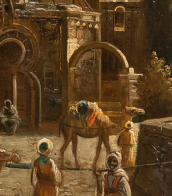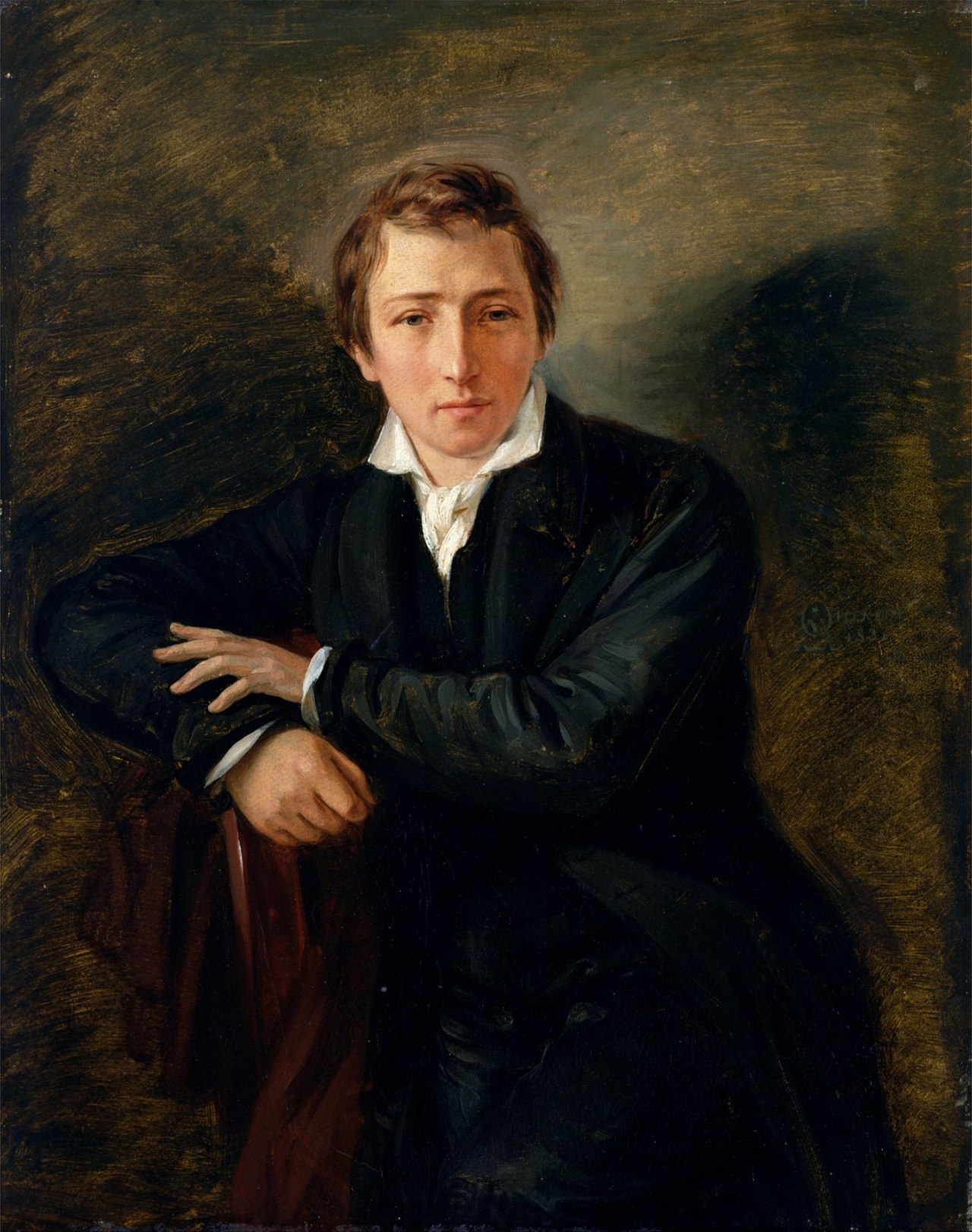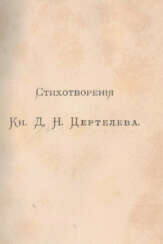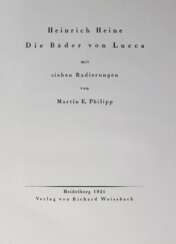гейне




Johann Adalbert Heine was a German painter.
It is known about the artist that he worked in Munich, painted portraits and everyday scenes with ordinary people, mostly in taverns.


Thomas Theodor Heine was a German-Swedish artist of late nineteenth and early twentieth centuries of Jewish origin. He is known as a painter, draftsman, illustrator and writer.
Heine co-founded the popular German satirical weekly Simplicissimus, where he printed his drawings and caricatures. He also collaborated with the magazines Flying Pages and Youth, illustrated books, and created advertising posters and erotic drawings. After the Nazis came to power, the artist fled to Sweden, where he obtained citizenship. His works were presented at a retrospective anniversary exhibition in Stockholm in 1947, a year before Heine's death.


Johann Adalbert Heine was a German painter.
It is known about the artist that he worked in Munich, painted portraits and everyday scenes with ordinary people, mostly in taverns.


Christian Johann Heinrich Heine was a German poet and writer, known for his lyric poetry that has been set to music as Lieder by composers such as Schumann and Mendelssohn. Born as Harry Heine in Düsseldorf, he later became one of the most significant figures in German Romantic literature. His works exhibit a range of themes, from the humorous to the serious, and he is celebrated for making the language of everyday life suitable for poetry.
Heine's contributions to literature go beyond poetry; he was also a journalist and essayist. His prose works, like "Reisebilder," mix travelogue with literary critique, and his sharp wit and satire often targeted the social and political issues of his time. These features made him a pioneering figure in the transition from German Romanticism to Realism.
In museums, Heine's original manuscripts and early editions of his works are prized possessions. They connect collectors and literary enthusiasts to a pivotal era of literary change. For those who cherish the romance of words intertwined with the authenticity of history, seeking out Heine’s works can be a rewarding endeavor. Explore his literary artistry and consider adding a piece of his legacy to your collection.


Christian Johann Heinrich Heine was a German poet and writer, known for his lyric poetry that has been set to music as Lieder by composers such as Schumann and Mendelssohn. Born as Harry Heine in Düsseldorf, he later became one of the most significant figures in German Romantic literature. His works exhibit a range of themes, from the humorous to the serious, and he is celebrated for making the language of everyday life suitable for poetry.
Heine's contributions to literature go beyond poetry; he was also a journalist and essayist. His prose works, like "Reisebilder," mix travelogue with literary critique, and his sharp wit and satire often targeted the social and political issues of his time. These features made him a pioneering figure in the transition from German Romanticism to Realism.
In museums, Heine's original manuscripts and early editions of his works are prized possessions. They connect collectors and literary enthusiasts to a pivotal era of literary change. For those who cherish the romance of words intertwined with the authenticity of history, seeking out Heine’s works can be a rewarding endeavor. Explore his literary artistry and consider adding a piece of his legacy to your collection.


Christian Johann Heinrich Heine was a German poet and writer, known for his lyric poetry that has been set to music as Lieder by composers such as Schumann and Mendelssohn. Born as Harry Heine in Düsseldorf, he later became one of the most significant figures in German Romantic literature. His works exhibit a range of themes, from the humorous to the serious, and he is celebrated for making the language of everyday life suitable for poetry.
Heine's contributions to literature go beyond poetry; he was also a journalist and essayist. His prose works, like "Reisebilder," mix travelogue with literary critique, and his sharp wit and satire often targeted the social and political issues of his time. These features made him a pioneering figure in the transition from German Romanticism to Realism.
In museums, Heine's original manuscripts and early editions of his works are prized possessions. They connect collectors and literary enthusiasts to a pivotal era of literary change. For those who cherish the romance of words intertwined with the authenticity of history, seeking out Heine’s works can be a rewarding endeavor. Explore his literary artistry and consider adding a piece of his legacy to your collection.


Cincinnatus Heine Miller, better known by his pen name Joaquin Miller, was an American writer and poet and journalist.
Miller spent his youth traveling across the country and in California among miners, gamblers, and Indians. During the Gold Rush, he had to endure many misadventures. He attended Columbia College (Eugene, Oregon) and was admitted to the Oregon State Bar in 1860.
From 1862-1866 he published the Eugene Democratic Register newspaper and was a county judge in Oregon. For the Register, he wrote an article in defense of Mexican bandit Joaquin Murietta, whose name he later took as a pseudonym. In the late 1860s his first collections of poems, Samples and Joaquin, were published.
In 1870 Miller traveled to England, where thanks to exotic manners and bright costume in the style of Westerns became popular among the literati and published several collections of poems. Among them was a book, Songs of the Sierra, which established his nickname "The Poet of the Sierra." He became a kind of celebrity among the Pre-Raphaelites, he was honored by the British press, he attended the Savage Club as a guest of Nathanial Hawthorne's son Julian, who called him a "licensed libertine."
Joaquin Miller's best works convey a sense of the grandeur of the Old West. His most famous poem is "Columbus."


Johann Adalbert Heine was a German painter.
It is known about the artist that he worked in Munich, painted portraits and everyday scenes with ordinary people, mostly in taverns.


Christian Johann Heinrich Heine was a German poet and writer, known for his lyric poetry that has been set to music as Lieder by composers such as Schumann and Mendelssohn. Born as Harry Heine in Düsseldorf, he later became one of the most significant figures in German Romantic literature. His works exhibit a range of themes, from the humorous to the serious, and he is celebrated for making the language of everyday life suitable for poetry.
Heine's contributions to literature go beyond poetry; he was also a journalist and essayist. His prose works, like "Reisebilder," mix travelogue with literary critique, and his sharp wit and satire often targeted the social and political issues of his time. These features made him a pioneering figure in the transition from German Romanticism to Realism.
In museums, Heine's original manuscripts and early editions of his works are prized possessions. They connect collectors and literary enthusiasts to a pivotal era of literary change. For those who cherish the romance of words intertwined with the authenticity of history, seeking out Heine’s works can be a rewarding endeavor. Explore his literary artistry and consider adding a piece of his legacy to your collection.


Christian Johann Heinrich Heine was a German poet and writer, known for his lyric poetry that has been set to music as Lieder by composers such as Schumann and Mendelssohn. Born as Harry Heine in Düsseldorf, he later became one of the most significant figures in German Romantic literature. His works exhibit a range of themes, from the humorous to the serious, and he is celebrated for making the language of everyday life suitable for poetry.
Heine's contributions to literature go beyond poetry; he was also a journalist and essayist. His prose works, like "Reisebilder," mix travelogue with literary critique, and his sharp wit and satire often targeted the social and political issues of his time. These features made him a pioneering figure in the transition from German Romanticism to Realism.
In museums, Heine's original manuscripts and early editions of his works are prized possessions. They connect collectors and literary enthusiasts to a pivotal era of literary change. For those who cherish the romance of words intertwined with the authenticity of history, seeking out Heine’s works can be a rewarding endeavor. Explore his literary artistry and consider adding a piece of his legacy to your collection.


Aratus Solensis was an ancient Greek didactic poet.
It is known that he was a native of the ancient city of Soli in Cilicia, and studied under the famous philosophers of his time in Ephesus, Cos and Athens. Around 276 BC, Aratus was invited to the court of the Macedonian king Antigonus II Gonatus and expounded in verse his victory over the Gauls. Here he also wrote his most famous work in modern times, the hexameter poem Phenomena, which sets forth the astronomical knowledge of the time. He then spent some time at the court of Antiochus I Soter of Syria and returned to Macedonia.
The poet's second extant poem is Diosemeia ("On the Omens of the Weather"). These two poems by Aratus were very popular in both the Greek and Roman worlds. He was translated and quoted by Ovid and Cicerone, and a translation into Arabic was made in the 9th century.
In addition to poetry, Aratus practiced medicine, grammar, and philosophy.

Jacob de Gheyn III was a Dutch artist, painter and printmaker of the Golden Age.
He was the son of Jacob de Gheyn II, canon of Utrecht, engraver and graphic artist, a favorite royal artist who designed a garden in The Hague for the royal family. And his grandfather was a miniaturist and glass painter. De Gheyn learned etching from his father, then studied in Leiden with Constantin and Maurits Huygens. Thanks to his rich inheritance, he did not bother to work. After traveling to London and Sweden in 1620, Jacob de Gheyn III lived in The Hague and then moved to Utrecht, where he became a canon of St. Mary's Church and lived until the end of his life.
Jacob de Gheyn III patronized Rembrandt, who painted a portrait of him in 1632. This portrait has become famous in modern times for being mentioned in the Guinness Book of Records as the most frequently stolen painting and even bears the nickname "Rembrandt to take away".







![Фет, А.А. Полное собрание стихотворений А.А. Фета: [в 3 т.] / Под ред. Б.В. Никольского.](/assets/image/picture_4216370/b98e1/kvf5cdizdo4-yc9pecsvf0qdbbsotggjbqynrsnxt7vmqi9fco6bvxee2slzv51727119901jpg__fix_374_244.jpeg)
![Фет, А.А. Полное собрание стихотворений А.А. Фета: [в 3 т.] / Под ред. Б.В. Никольского.](https://veryimportantlot.com/assets/image/picture_4216370/b98e1/kvf5cdizdo4-yc9pecsvf0qdbbsotggjbqynrsnxt7vmqi9fco6bvxee2slzv51727119901jpg__fix_374_244.jpeg)






















